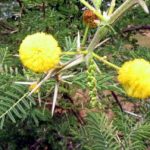TREE LIFE
October 2012
MASHONALAND CALENDAR
October 21st: Dr Tom Mueller’s birthday lunch, 12 noon, National Botanic Garden Restaurant with a walk in the Gardens at 10.30am. Please contact Mark Hyde or the Editor before 12th October if you would like to attend.
October 27th (4th Saturday): Outing to Dave Hurtung’s garden in Mt Pleasant. Details to follow by email.
TREE SOCIETY VISIT TO CATAPú, SOFALA, MOZAMBIQUE. Friday, April 6th – Sunday, April 15th, 2012
Episode 6
Wednesday 11th April: Logging Operations on the Nhamacalapia Road at Catapú
I would love to be writing about the night sounds of Catapú, so richly in need of documentation. But the offer was politely declined when I heard a distant hyena, missing its lower register, impersonating a wood owl. Instead I was asked if I would cover logging operations.
Wednesday April 11th was designated the day for our visit to the sites of arboreal massacre at Catapú. Mercifully for most of us, the heart-stopping sounds of centuries-old hardwoods crashing to the ground had only been witnessed in TV documentaries. Was it just ghoulish fascination that made me want to be party to this day of blood and gore? Would I be overcome with emotion, and lunge forward to chain myself to the trunk of one of those mighty Cordylas before the chain saw could bite into its flesh? Three vehicles of for-once wordless Tree Society members set off through the light rain. Even Karl, Meg and the other John had put on hold their verbal sparring for the grim occasion.
But no, this was one logging site we would leave feeling not despair for the future of the planet, but inspired. It was my first in-the-flesh view of a logging operation putting sustainability at the top of the agenda. It inspires hope that a priceless resource can be preserved, if only sentiment does not get in the way.
For sure, the forests and woodlands of the world will not be saved because you or I feel sentimental about such things. They may be saved, however, if enough of the other 95% who are not tree-huggers, see profit in it. Catapú is the pioneer, but the enthusiasm and involvement of the resident community lead me to believe surrounding forest concessions may in time follow the example. That would be a far better template for success than government regulation could ever be. Sadly poverty and corruption go hand-in-hand in most parts of the world blessed with such resources.
No timber extraction is undertaken during the rains, to avoid among other things, soil compaction. On our drive to the latest (2011) logging site, we passed through the blocks that had been logged during the successive years from 2006. I for one would have struggled to tell a logged block from one unlogged, partly because between 20 and 25% of mature hardwoods are left standing. A logged “commercial” stand is often in a far more sound ecological state than an adjacent unlogged “semi-marginal” one. The Mozambique authorities have set a minimum diameter of 300mm for logging. Catapú observes a 450mm minimum.
As we all know, statistics can shed more confusion than light on a subject. “Recovery” statistics on the Catapú timber operation come in many shapes and sizes. About 2 m3 of sawn logs are recovered from a mature tree. The recovery of furniture ranges from 26% for Panga Panga logs to 38 – 40% for Chamfuta.
The word “recovery” gives a nice feeling in the stomach. But that awesome Cordyla that it took almost three of us to embrace with hands touching, is gone for good. Converted into jobs and products for a hungry world. Or is it? That brings us to a third “recovery” statistic. Between 75 and 80% of felled Panga Panga (Millettia stuhlmannia) coppice. Even the rate of 40% for Afzelea quanzensis and Cordyla africana are encouraging.
All stumps and logs are marked with a serial number, the month and year of logging, and the names of the plotter and logger. This enables follow-up to monitor the successes and failures of the forest regeneration effort. The dozens of coppice volunteers are reduced to the 3 strongest at the end of the first year, then successively managed until the one strongest remains after 3 years. Pruning is done to ensure minor branching does not weaken the main trunk. The phenomenal rate of re-growth on an established root-system can be attested by any of us with even an amateur’s experience of such things.
Regeneration is also undertaken by seed, both in situ and most successfully, in nursery planting bags. We saw how furrowed drag-lines have been scuffled and harrowed after all the logs have been hauled to the loading ramps. This mildly disturbed area, incorporating leaf fall and other organic matter, then becomes an ideal medium in which to plant seed. We also saw the widespread use of the Catapú Gate, both within the logged areas and by the local communities, to protect seedlings from certain destruction by porcupines and antelope.
I am sure I speak for all privileged to have been on this tour, when I say “hats off” with the deepest respect for all Meg and Ant are doing at Catapú. They are showing that to save trees you may have to go beyond hugging, to giving them the chop. It can be done sustainably and sensitively.
-John Bennett
Thursday 12th April. A walk along the Tissadze River at Catapú
The day started with finding an orchid, Habenaria sp., one with large white flowers (this genus usually has smallish greenish-yellow flowers), which was the first record of a terrestrial orchid at Catapú. It is similar to and may even be Habenaria stylites.
There was a surprising lack of aliens at Catapú, even in the disturbed areas. Hyptis suaveolens, an aromatic labiate, is one of the few. We also saw Tridax procumbens, a very successful invader in Zimbabwe, in a small colony near the dining area at Mpingue Lodge.
On our way past the sawmill and on the way down to the Tissadze River, we stopped and looked for Commiphora neglecta which we found near the school. This is a small tree with blue-green peeling bark and trifoliate leaves rather like C. schimperi and C. africana, and many spine-bearing branches. Its distribution is usually more coastal, so it was an exciting find.
We walked up the dry sandy river bed, looking at trees on the East bank. Dalbergia arbutifolia was interesting – very common in the riverbed, it is a semi-climber with pinnate leaves and winged pods. It is similar to Rourea orientalis and often you need the fruit and flowers to be able to separate them, except that Rourea is normally not riverine. Glyphaea tomentosa (not found in Zimbabwe) resembles a yellow-flowered Grewia but differs in having elongated rigid fruits very different from the spherical fruits of Grewias. We came across typical riverine species such as Combretum adenogonium, Kigelia africana, (the sausage tree), Hyphaene coriacea (ilala palm), Ficus sycomorus, Xeroderris stuhlmannii, Artabotrys brachypetalus and Tamarindus indica (Tamarind). But amongst all those trees that might be seen in a Zimbabwean river bed there were also some Mozambican species such as Cola mossambicensis, which is similar to the single Zimbabwean species of Cola greenwayi in possessing a swollen petiole just below the leaf blade. Meg showed us a species of Ficus lingua, a strangler fig high up in a riverine tree but too high to really see what it was.
We staggered back along the river bed through light rain, back to the cars. Meg showed us the leaves of Combretum pisoniiflorum, a climber that has no wings on its fruit, another Mozambique special. Half the party returned to the Lodge while Meg et al. went on to look for Newtonia hildebrandtii, which we didn’t find.
The second walk of the afternoon took off on the Suni North path to find the Newtonia hildebrandtii. We went through very fine trees, among them Monodora stenopetala, Terminalia sambesiaca and a beautiful large Erythrina livingstoniana with magnificent spiny bosses on its trunk. There were several multi-stemmed but fused together Diospyros with spiny branches senensis (also found in Zimbabwe). We finally found two large, very fine Newtonias just before the fig that straddles the path, Ficus bussei.
The walk was longer than expected and with night coming on we were rescued by Richard Dennison and John Bennett who had been dispatched to fetch the cars.
TO BE CONTINUED………..
TREE OF THE MONTH
Erythrina abyssinica and Erythrina latissimi
Family: – Fabaceae – Papilionoideae
Botanical names: – Erythrina abyssinica / Erythrina latissima
Common names: – Red-hot Poker Coral-tree / Broad-leaved Coral-tree/ Nd: Umgqogqogqo; Sh: Mutiti.
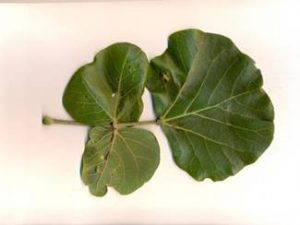
Erythrina abyssinica leaves
The Papilionoideae are well know to you as they include all the Pterocarpus, Baphia, Indigofera, Mundulea and many more.
The reason I am treating E. abyssinica and E. latissima together is because they are both common in this part of the country and also to try and highlight the differences between them, particularly at this time of the year as they flower before the leaves come back.
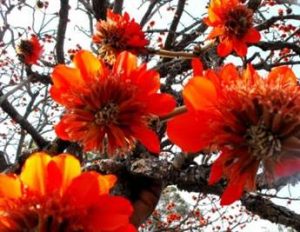
Erythrina abyssinica flowers
Above you will see a picture of a “typical” abyssinica flower. Now when I say “typical” don’t take me too seriously, flowers on both start with tubular petals, the abyssinica gradually evolve to a ‘pompom’ look while the latissima keeps looking like a “traditional” flower as seen in the picture below. The inflorescences of abyssinica are (generally) vertical, while the inflorescences of latissima tend to be held horizontally. The problem with trees and flowers is that they seldom read the cogitations of our more erudite pundits and tend to do their own thing.
When the leaves make their appearance the determination of the species becomes a little easier. In E. abyssinica the two bottom leaflets are well below the end leaflet and there is no overlap. (picture of abyssinica’s leaf and pods above). The bark of abyssinica often has knobby prickles.
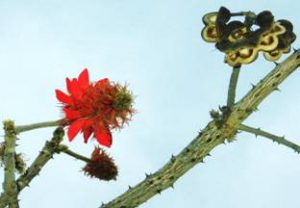
Knobby prickles on Erythrina abyssinica
In E. latissima the lateral leaflets overlap the end one (a leaf, pod and flower of latissima are shown on the right). Also notice that the leaflets of abyssinica are more circular and latissima more ovoid. The bark of latissima does not (or should not) have knobby prickles.
The seeds of Erythrina are said to contain a curare-like poison. I have read very diverging opinions on the potency of the poison, from no effect whatever to death. In the days before I studied trees and ignorance being bliss, my daughters all wore necklaces of Lucky Beans and, like all kids, chewed on the beads with no ill effects.
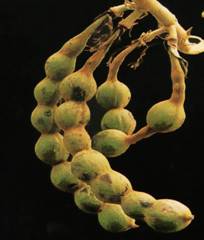
Erythrina pods
At the risk of being incorrect, the thought has occurred to me that E. abyssinica and E. latissima might even hybridise. Some of the trees along the Mutare road are, at the least, perplexing.
All Erythrina grow easily both from seeds and truncheons but don’t plant them too close to your house, the roots are quite invasive.
-JP Felu


